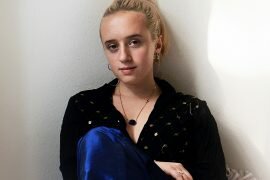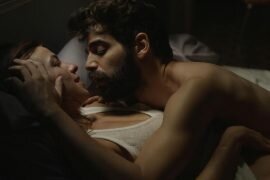After his loquacious vitriolic comedy, “Listen Up, Philip”, American independent filmmaker Alex Ross Perry is at the Berlinale this year with an altogether different kind of movie called Queen of Earth. A meticulous depiction of a mental breakdown, Perry’s new film, starring Elizabeth Moss and Katherine Waterston, is as a surprising a follow up as it is brilliant and unsettling.
Catherine (Elizabeth Moss) is recovering, albeit poorly, from a breakup and the suicide of her father and in an attempt to work through her issues spends a week at a lakeside cabin with her best friend Virginia (Katherine Waterston). It doesn’t take long, however, for their friendship to turn nearly sadistic, and as the days progress Catherine’s mind begins to slowly unravel.
The Berlin Film Journal interviewed Alex Ross Perry about his new film, which is being screened in the Forum section of the festival.
It becomes obvious during the opening credits that this is going to be a very different film compared to your previous ones. What was your motivation behind such a huge change in genre?
Well, just fun and not being bored, and trying something different. The movie came together with Joe Swanburg, the producer, saying that we should make a small movie and here are the production parameters that I can offer .I could have done another very dialogue driven Brooklyn comedy, but then we would just be doing the same (as in “Listen Up Philip”) with far fewer resources, which would be really unfun and compare unfavorably. So it was just out of my own interest of trying something different, and the fact that I didn’t think that I could top myself doing the same thing, nor would I want to try.
You are dealing with similar themes in this film as in “Listen Up Philip”, such as depression and miserable people, only in completely different ways. Where did this particular story come from?
At the time that the movie was coming together and a lot that I was very interested in doing were questions that I had about privacy and entitlement, and this society we live in that prioritizes information and gossip. Not that the film takes places in any explicit modern digital internet age, but information is currency, and the more you know about things that other people don’t know, the more valuable your opinion is. I found that very interesting and troubling, so I wanted to do a movie that was my own version of that problem that I’m just very fascinated by.
In watching the movie I started to think of other movies like “The Bitter Tear of Petra von Kant” by Fassbinder and “Rosemary’s Baby” by Roman Polanski. What were your reference points for this film?
Yeah, all that stuff. There is connection between movies that are dramas and ones that are horror/thrillers. If it’s in the realm of cinema dealing with broken women, then it can be broken women in one room in a Fassbinder movie or broken women in a Polanski film, or “Carnival of Souls.” Overt horror films that deal with the same imagery and the same narrative hurtles put in front of a woman as in a drama like Woody Allen’s “Interiors.” All of these things are very connected to me and it just felt like a fun type of movie to be making, which is an incredible amount of diverse movies to be talking about. But for me there is something about all those movies that unites them, and making a movie that lives in those traditions was really fun challenge for me.
Were you afraid of falling into certain tropes that come along with making a particular movie like that, one dealing with broken women?
No, but only because whenever I try to do something I do it as well as I can, and it ends being the wrong version of it. With “Listen Up Philip” I tried to make a funny, accessible, literary comedy, and what I ended up with was a movie that people said was so bleak, and negative and unlikeable, and I thought, “Really? For me this was a funny, enjoyable crowd- pleasing movie. So with this one [“Queen of Earth”], I could try my hardest to make a horror/thriller and I would end up failing in a way that’s interesting, by ending up with a very human, very real drama that brings those elements into the movie. I kept saying that people might want to categorize this as a midnight movie, because it would have a similarity to some of the horror films we’re talking about. But if it would be a midnight movie everyone would be asleep by one, because nothing has happened that justifies the movie being played at midnight. By one all you would have seen are two sad women talking to each other about their friendship- that’s not a midnight movie.
While writing the script did you already have Elizabeth Moss in mind for the part of Catherine?
Yeah, I was thinking about her while writing this because it was soon after we worked together on “Listen Up Philip”. I was thinking how great it would be to get her to do this, because it was something, I felt, was entirely unfamiliar territory for her to be performing in, and for people that like watching her, it would be something completely different. She immediately saw it as an incredibly fun challenge, and as a very trusting continuation of the groundwork we had found for our working relationship on “Listen Up Philip”.
Was she involved in the casting process, and did she help in choosing Kate Waterston to play Virginia?
She became involved immediately, and with her as a producer, she was doing way more work than the regular cast of a movie would be doing. She became really involved in reaching out to other actors. Most movies you just say, “Hey, look who we’re casting”, but on this movie, because she was the lead and the producer, every time I got an idea I would ask her what she thought and Katherine Waterston was someone that we both felt really strongly about.
At the beginning of every scene you never what the tone is going to be. A scene will start off light-hearted between the two friends, but then there’ll be a tonal shift, and they end up being very mean and cruel to each other. Was that in the script or did it come during the shot?
I think a lot of that was clear in the material. I would never write that there is a tonal shift occurring, but a lot of it was quite apparent. Also the movie was shot entirely chronologically, so the shifts became very organic and very obvious to the actresses and me and where they need to be. And if a shift occurs and we’re going in order, then we can just build off of that. The movie doesn’t have a disjointed feel, whereas if we had shot it the way normal movies are done, there might be some tonal issues.
I want to talk about one scene in particular where Catherine and Virginia deliver these monologues to each other about their failed relationships while the camera slowly pans from one face to the other, and focuses on the one face while we are hearing the voice of the other. How did that composition come about?
I don’t really remember, but the blocking of that scene with the two women posed on the bed is the “The Bitter Tears of Petra von Kant” influence mentioned earlier. You know, that film is all in one room with those two women sitting on that bed posed very artificially – that was something very interesting to do in a nine minute shot with two dueling monologues, and I don’t think of that as something existing outside of very groundbreaking European cinema from 40 years ago.
It was very refreshing to see something like that.
Well, it’s interesting. There is one film I was watching before we started shooting that had a preponderance of things where the coverage was not who was talking. Entire scenes would be constructed of just reaction shots, and I was talking about this with Sean William Price, the cinematographer, about how some elements of this movie should not be on people when they are talking. We figured this scene is already pushing the envelope in terms of what’s normal and what’s not, we might as well make this scene where for a minute at a time you’re just looking at someone’s face whose listening.
I had a real physical reaction to the sound design and the music. Could you talk about where that came from?
It’s the same composer as on “Listen Up Philip”, Keegan de Witt, and since that was not that long after before making this movie, and I knew what he was capable of, I felt comfortable throwing a whole different set of challenges at them. For this movie, I was talking to Keegan before we started shooting and sending him films and clips that were meant to be inspirational in the rules of what music in films like this feel like. Then he was scoring to the dailies, and sending us music on set. His contribution was really early this time, and allowed the editing to take shape around the final music. That was very beneficial. Again, those are just the rules of this sort of film. I talked about “Images”, the Robert Altman film, which has a John Williams score, but also this composed soundscape by a Japanese musician that creates an incredibly complex sound design layers, which for that film makes it feel unique and powerful and strange. That’s kind of what you need for a movie like this.
How do you think others will respond to this film?
I have no idea. I’ve never watched the film with anybody yet except for two or three people at a time in the editing room. With “Listen Up Philip” we would have these screenings of 15 to 20 people, and I would feel the vibe of the movie on friends and people that I trusted. We never did that with this, so I’m really going to be surprised when I sit down in room with people and see how the film affects them. It’s not a comedy so there will be no one moment when I know that the audience is with us. I won’t be able to feel the enthusiasm of the audience the way you can with a movie that has jokes in it, so I’m very curious to see what happens.




